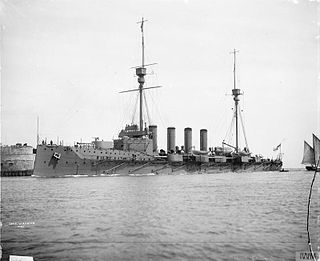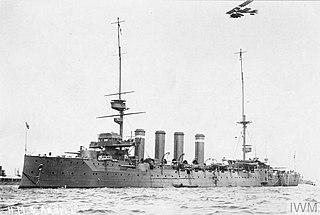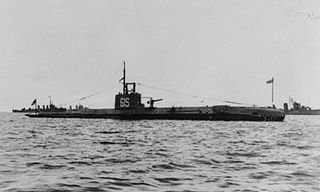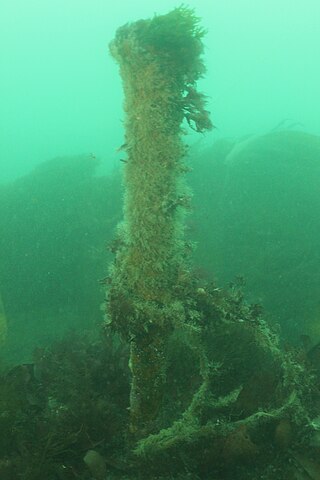Related Research Articles

HMS Warrior was a Warrior-class armoured cruiser built for the Royal Navy in the first decade of the 20th century. She was stationed in the Mediterranean when the First World War began and participated in the pursuit of the German battlecruiser SMS Goeben and light cruiser SMS Breslau. Warrior was transferred to the Grand Fleet in December 1914 and remained there for the rest of her career. She was heavily damaged during the Battle of Jutland in 1916, after which she withdrew and was later abandoned and sank in a rising sea.

HMS Argyll was one of six Devonshire-class armoured cruisers built for the Royal Navy in the first decade of the 20th century. She was assigned to the 1st Cruiser Squadron of the Channel Fleet upon completion and was transferred to the 5th Cruiser Squadron of the Atlantic Fleet in 1909. Two years later, she was detached to escort the royal yacht during King George V's trip to British India. Argyll was assigned to the 3rd Cruiser Squadron of the reserve Second Fleet in 1913.

HMS Defence was a Minotaur-class armoured cruiser built for the Royal Navy in the first decade of the 20th century, the last armoured cruiser built for the Royal Navy. She was stationed in the Mediterranean when the First World War began and participated in the pursuit of the German battlecruiser SMS Goeben and light cruiser SMS Breslau. The ship was transferred to the Grand Fleet in January 1915 and remained there for the rest of her career.

SS Thistlegorm was a British cargo steamship that was built in North East England in 1940 and sunk by German bomber aircraft in the Red Sea in 1941. Her wreck near Ras Muhammad is now a well-known diving site.

HMS Swordfish (61S) was a first-batch S-class submarine built for the Royal Navy during the 1930s. Commissioned in 1932, she was given the pennant number 61S and was assigned to the 2nd Submarine Flotilla.
SS Vyner Brooke was a Scottish-built steamship that was both the royal yacht of Sarawak and a merchant ship frequently used between Singapore and Kuching. She was named after the 3rd Rajah of Sarawak, Sir Charles Vyner Brooke. At the outbreak of war with Japan the ship was requisitioned by the Royal Navy, armed, and sunk in 1942.

HM Trawler Force was a British trawler built for the Royal Navy in the First World War and subsequently requisitioned for service in the Second World War. She was sunk by air attack in June 1941.

HMS Natal was a Warrior-class armoured cruiser built for the Royal Navy in the first decade of the 20th century. She escorted the royal yacht in 1911–1912 for the newly crowned King George V's trip to India to attend the Delhi Durbar. During World War I the ship was assigned to the 2nd Cruiser Squadron of the Grand Fleet, but did not participate in any battles. Natal was sunk by an internal explosion near Cromarty on 30 December 1915 with the loss of at least 390 crewmen and civilians. Most of her wreck was slowly salvaged over the decades until the remnants were demolished in the 1970s so they were no longer a hazard to navigation. The remains of her wreck are designated as a controlled site under the Protection of Military Remains Act 1986 as a war grave.

HMS Port Napier (M32) was a minelayer of the British Royal Navy during World War II, which was destroyed on 27 November 1940 in Loch Alsh, Scotland, by an explosion following an engine room fire.

HMS Himalaya was built for the Peninsular and Oriental Steam Navigation Company as SS Himalaya, a 3,438 gross register ton iron steam screw passenger ship. She was purchased by the Royal Navy in 1854 for use as a troopship until 1894 and was then moored in the Hamoaze, Devonport to serve as a Navy coal hulk until 1920, when sold off. She was sunk during a German air attack on Portland Harbour in 1940.
Five ships of the Royal Navy have borne the name HMS Breda, after the Declaration of Breda:

Glen Strathallan was a British ship originally built as a trawler, but then converted into a private yacht, which also served in the Royal Navy in World War II. She was finally scuttled in 1970 at Plymouth Sound, England as a diver training site.
The Maritime history of Scotland involves events including shipping, ports, navigation, and seamen, as well as marine sciences, exploration, trade, and maritime themes in the arts of Scotland.

Dieppe was a steam passenger ferry that was built in 1905 for the London, Brighton and South Coast Railway. She was requisitioned during the First World War for use as a troopship and later as a hospital ship HMS Dieppe, returning to her owners postwar. She passed to the Southern Railway on 1 January 1923. In 1933 she was sold to W E Guinness and converted to a private diesel yacht, Rosaura. She was requisitioned in the Second World War for use as an armed boarding vessel, HMS Rosaura. She struck a mine and sank off Tobruk, Libya on 18 March 1941.

HMAS Goorangai was a 223-ton auxiliary minesweeper of the Royal Australian Navy (RAN). She was built in 1919 for the Government of New South Wales, then sold in 1926 to the fishing company Cam & Sons. The trawler was requisitioned for military service following the outbreak of World War II, converted into a minesweeper, and assigned to Melbourne. She was sunk in an accidental collision with MV Duntroon in 1940, becoming the RAN's first loss of World War II, and the first RAN surface ship to be lost in wartime.
HMT Lincoln City was an anti-submarine warfare (ASW) trawler in the service of the British Royal Navy during World War II. She was bombed during an air raid and sank on 21 February 1941 at the Faroe Islands.
HMS Nasturtium was an Arabis-class sloop built in Scotland and launched in 1915.
Kuroshio Maru was a tanker that was built in 1938 for Japanese owners. She was chartered by the Imperial Japanese Navy and Imperial Japanese Army during World War II: the ship was sunk in January 1945 at Takao, Formosa by American aircraft. Salvaged in 1946, she was allocated as a war prize to China and renamed Yung Hao, but was forced to remain at Hong Kong by the British. She was requisitioned by the Admiralty during the Korean War and allocated to the Royal Fleet Auxiliary. She was to have been named RFA Surf Pilot but due to her poor condition she did not serve in the Royal Fleet Auxiliary. She served as Surf Pilot, a tender to HMS Terror until 1958 and was subsequently scuttled off Pulau Aur, Malaya in 1960.
HMS Snaefell was a paddle steamer, built at John Brown & Company's Clydebank shipyard for the Barry Railway Company and launched on 1907 as the PS Barry. Built to serve as a pleasure steamer carrying passengers on the Bristol Channel, she was quickly transferred to the ownership of Bristol Channel Passenger Boats which in 1911 became part of P & A Campbell.
HMS Crispin was a British cargo steamship that was launched in England in 1934 and operated by Alfred Booth and Company between Liverpool and the east coast of South America. In 1940 the British Admiralty requisitioned her and had her converted into an ocean boarding vessel. In 1941 a U-boat sank her in the Battle of the Atlantic, killing 20 of her crew.